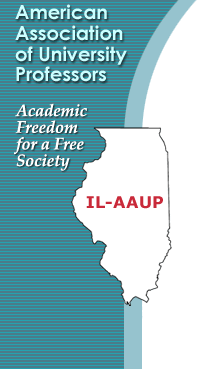Home | IL Academe | About IL AAUP | Conference Corner | Calendar | Services | Committees | Contact Us | Grants | Reports | Links
 |
 |
 |
Museum Curators and the AAUP By Patrick Ryan Williams, Bruce Patterson, Margaret Thayer, and Ken Angielczyk, AAUP-FMNH 2009 officers Many university professors may wonder what museum curators have to do with the professoriate. They may think of us as stodgy collectors, hoarding specimens away in dark hallways. Especially in those disciplines in which specimen-based research is not a core component of scholarship, museum curators can often be overlooked as part of the academy. Yet, The Field Museum in Chicago recently formed its own chapter of the AAUP, and museum teachers, researchers, and scientists are proclaiming their role as educators and their concerns with academic freedom and governance in non-traditional settings for AAUP chapters. The Field Museum of Natural History is one of the three largest academic research museums in the country, along with the National Museum of Natural History (Smithsonian Institution) and the American Museum of Natural History. It is devoted to the discovery, documentation, and dissemination of information about the natural and cultural worlds. Its staff members discover through expeditions and research, document through encyclopedic collections and analyses, and disseminate this information through exhibits, educational programs and publications. Like all true museums, The Field Museum is built and organized around its collections, and is universally regarded as one of the world’s leading natural history museums, a peer among older and larger museums in New York, Washington and London. The Field Museum is governed by a Board of Trustees, led by a President, and has a full-time staff of over 500 employees. The scientific backbone of the museum is its curatorial faculty, composed of 30-40 scientists distributed among four departments: Anthropology, Botany, Zoology, and Geology. Curators have career (tenured) appointments after a tenure-track probationary period. Their performance is evaluated in four areas: research, curation, education, and service. The contribution to higher education, including teaching and chairing dissertation committees, is thus explicitly mentioned in the tenure policy, although without specific requirements (e.g., 25% teaching or some number of courses per year). Many aspects of curators’ research programs are ones that might equally well take place at a university – indeed, some individuals come to The Field Museum from university faculties, and others move to universities from the museum. As part of their job responsibilities, most curators serve on the faculty of partner institutions. The Field Museum itself has collaborative agreements with area universities dating back to the first half of the 20th century, including collaborative graduate programs with the University of Chicago (1944), the University of Illinois (1987), and Northwestern University (2001), and individual curators have appointments at a number of other institutions and serve additional programs as readers, outside members, or external examiners. Curators also teach classes, chair or serve on PhD committees, and mentor undergraduate, graduate and postdoctoral scholars as part of these programs. It quickly becomes clear that museum curators have a great deal in common with their colleagues in university settings. Indeed, in university museums, curators are most often members of the academic departments in which they hold tenure. The large, independent research museums like the Field are somewhat unusual in that they are not part of a university structure, but their faculties are very much a part of the professoriate. Our concerns mirror those of our colleagues in universities, although we have multiple administrations with which we interact in the course of our professional responsibilities. The formation of a chapter of the AAUP thus constitutes recognition by the curatorial faculty of the importance of the professoriate’s ideals. With over 80% of the museum’s full-time tenured and tenure-track faculty listed as charter members, the chapter has strong endorsement. The chapter’s charter statement, appended here, expresses the aspirations and goals of a unified faculty, self-determined to preserve the conditions necessary to promote higher learning and academic freedom in the academy. American Association of University Professors Individual curators and departments at The Field Museum have long built successful relationships with area universities, through teaching, undergraduate and graduate student training, and program development. These educational enterprises, as well as museum-based post-doctoral training, have not yet been fully translated into widespread public recognition of the regional leadership role of the Museum’s science faculty in the education and advanced training of our nation’s future scientists and science administrators. The formation of the new AAUP Chapter at the Museum thus unites our diverse in-house science faculty under a shared set of common goals, giving the Museum a unified voice when we are communicating — and negotiating — with universities, granting agencies, foundations, and other organizations on matters concerning both teaching and the advancement of science education generally. This solidifies our standing in local, state, and federal initiatives in support of undergraduate, graduate, and post-graduate science education. The professionalization of the Museum’s scientific faculty through the establishment of the new AAUP Chapter thus builds on our past educational successes, and prominently enhances our educational goals and research mission by more fully realizing the contributions that Field Museum scientists have made and will continue to make to higher education.
|
|